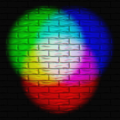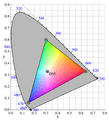RGB facts for kids
RGB, also called additive color mixing, is a color coding using light, with red, green, and blue. It is used in a hexadecimal code (#RRGGBB), with the left two digits with red, the center with green, and the right with blue. There can only be a maximum 255 of each color.
Images for kids
-
Additive color mixing: projecting primary color lights on a white surface shows secondary colors where two overlap; the combination of all three primaries in equal intensities makes white.
-
A set of primary colors, such as the sRGB primaries, define a color triangle; only colors within this triangle can be reproduced by mixing the primary colors. Colors outside the color triangle are therefore shown here as gray. The primaries and the D65 white point of sRGB are shown. The background figure is the CIE xy chromaticity diagram.
-
Cutaway rendering of a color CRT: 1. Electron guns 2. Electron beams 3. Focusing coils 4. Deflection coils 5. Anode connection 6. Mask for separating beams for red, green, and blue part of displayed image 7. Phosphor layer with red, green, and blue zones 8. Close-up of the phosphor-coated inner side of the screen
-
RGB phosphor dots in a CRT monitor
-
RGB sub-pixels in an LCD TV (on the right: an orange and a blue color; on the left: a close-up)
See also
 In Spanish: RGB para niños
In Spanish: RGB para niños







